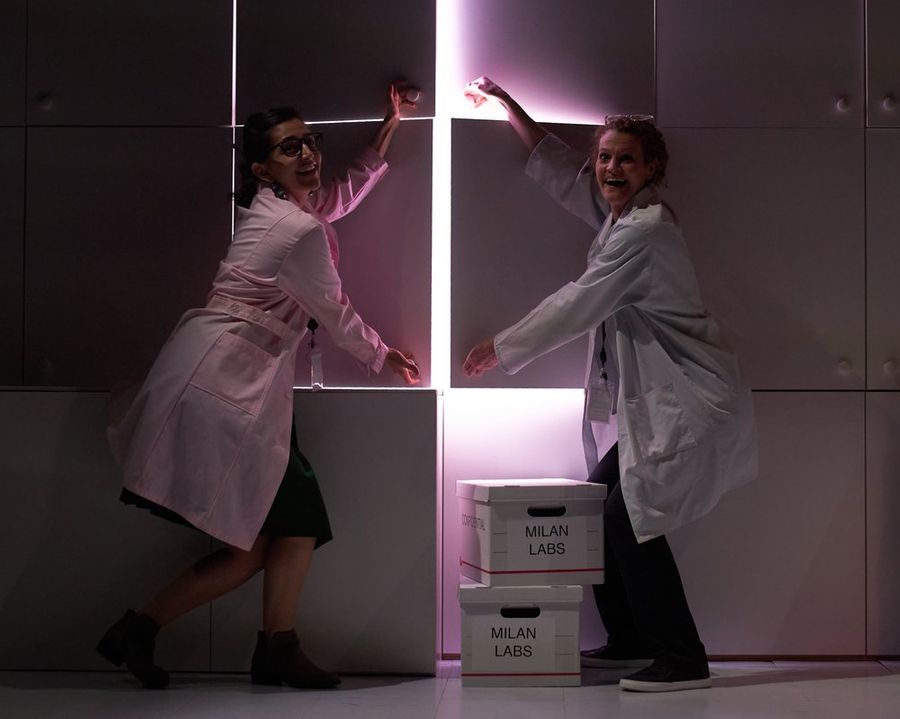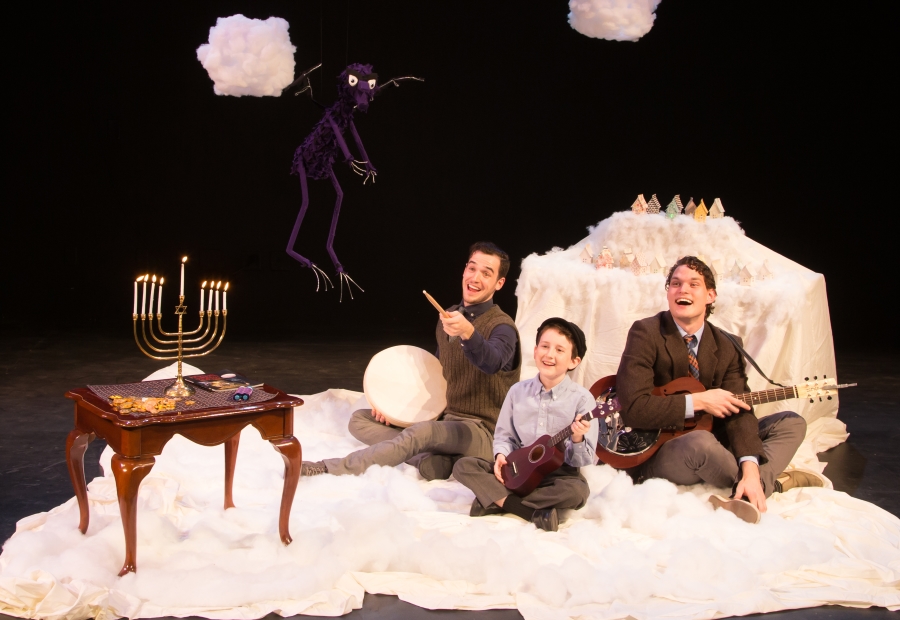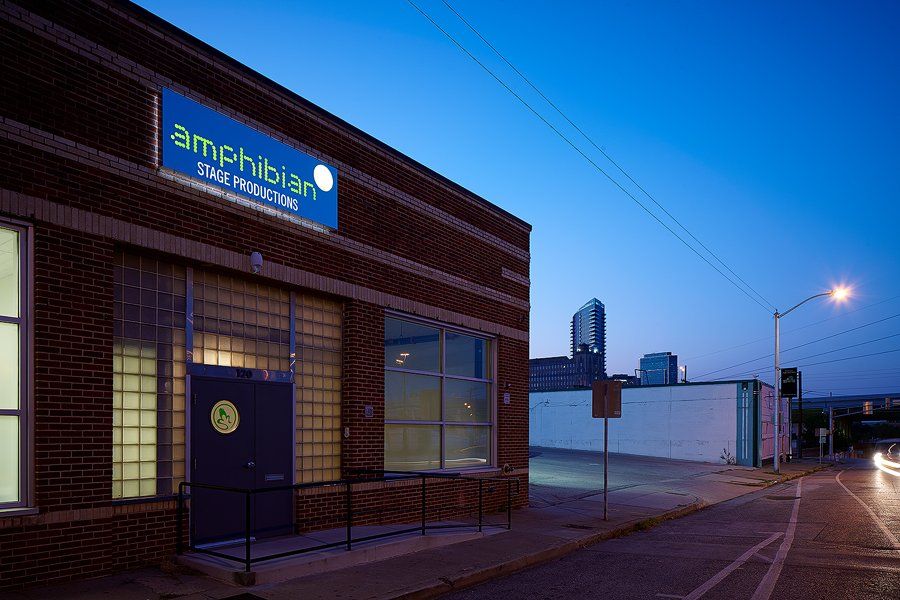FORT WORTH, TEXAS: Located in a one-story brick building on South Main that once housed lawn supply store, in the city’s Near Southside Cultural District, Amphibian Stage is walking distance from two other theatres, Stage West and Jubilee, and part of a lively neighborhood that includes restaurants like Tinie’s Mexican Cuisine, Brix Barbecue, and the Bearded Lady, as well as such bars as Tarantula Tiki Lounge, Nickel City, and the Holly. A relatively young company—just 22 years old, only 10 of those in their own space—Amphibian Stage has set itself apart with ambitious, even experimental new works like the performed-in-the-dark live audio play The True History of the Tragic Life & Triumphant Death of Julia Pastrana, the Ugliest Woman in the World, the local premiere of Fernanda Coppel’s King Liz, or the premiere of Sarah Saltwick’s The Pleasure Trials. We spoked to founding artistic director Kathleen Culebro recently by email about the theatre’s origins, purpose, and plans.
AMERICAN THEATRE: Who founded Amphibian Stage, when, and why?

KATHLEEN CULEBRO: In 2000, I co-founded Amphibian with a group of Texas Christian University alums and students. TCU generously allowed us to have full use of all their theatre spaces and equipment. Without this, I doubt we would have ever been able to make it more than a couple of years. We stayed for eight summers, completely rent-free, and were able to do the quality work they had taught us to do because of these resources. We wanted to continue to work together and to produce new work and plays that spoke about the issues we were interested in.
What sets your theatre apart from others in your region?
There are a lot of fantastic theatres in North Texas. We are all very close-knit and collaborative. I like to think Amphibian Stage is very community-focused and has some of the more unusual types of projects and collaborations. For example, one of our outreach projects involves teaching kids how to stilt dance in the style of traditions from around the world. We also collaborate with Stephan Wolfert’s De-Cruit program, taking what he has taught our team into a local prison where there is a veterans’ “pod.”
Our latest project is an augmented reality art walk through the neighborhood that is accessed through your smart phone. Existing works come to life and entirely virtual pieces appear on blank walls. This was our gift to the businesses around us who were struggling during the height of the pandemic. A grant from the Texas Commission on the Arts provided cultural tourism funding, and we thought it would be a fantastic way to get people into our neighborhood who might not know what a vibrant area it is.
Tell us about your favorite theatre institution other than your own, and why you admire it.
There are so many! It’s kind of cruel to make me pick just one. I always love to hang out at the National Theatre in London. It’s like Disneyland for theatre nerds like me. You can spend days seeing plays and enjoying the sight of so many theatre patrons of all kinds hanging out there. Locally, I really admire Kitchen Dog Theater for their bravery and passion for new work; Cara Mía Theatre is a small company doing incredibly bold work and engaging in some very exciting international partnerships.

How do you pick the plays you put on your stage?
This is such a difficult part of the job. So much is riding on how we select our season. Jay Duffer, my managing director (though he’s really more of a co-artistic director), and I read hundreds of scripts and see a huge number of plays. Anything I can get my hands on I read, stream, or attend. I travel a lot to New York and Chicago to see new plays and I develop a lot of relationships with writers, literary managers, and directors who send me scripts. I attend a lot of new play festivals—most recently at Two River Theatre and at the Alley. We then try to select things not many others are doing. We skew heavily toward world premieres. Those come with bigger risks, but as a playwright myself, I’m acutely aware of how few opportunities there are for playwrights. Our audiences trust us, and that gives us a lot of freedom to program plays that aren’t your traditional moneymakers.
What’s your annual budget, and how many artists do you employ each season?
Our budget is hovering just below $1,000,000. We employ about 200 artists per year. Spark Fest, our annual festival of new works and creative collaboration, alone gives us the opportunity to work with about 60 artists of all types.
How has your theatre adapted to COVID-19, and what does the prognosis look like?
COVID-19 made us even more dedicated to serving our community. It’s so rewarding to know that all of the theatres in your area and all of the small businesses in your neighborhood are coming together to help one another. I can’t tell you how much value it adds to our efforts to know that we are part of a bigger network of businesses trying to create something unique and special, and that we all have each others’ best interest at heart. A show that might have lower ticket revenue becomes less of a devastating proposition when the mission really focuses on something bigger and more important.

How has your theatre responded to calls for racial justice and more equitable working conditions put forward in documents like We See You, White American Theater, among others?
I think for so many of us in the arts our first reaction was to think we are doing fine and that others are the ones who need to change and learn. But we knew we needed an outside perspective to get an honest assessment of how Amphibian Stage was doing as an organization. So we hired a firm to do an in-depth audit of every aspect of our organization. The biggest thing we learned is that we needed a lot more transparency in our documentation and in our systems, so we are in the process of a major overhaul. We created a new program in 2020 titled This Is My Story, in which we bring in a professional storytelling coach and give community members from marginalized communities the tools they need to tell their stories. We are committed to paying non-union members and union members the same weekly fee (this is not new, but we hope to encourage others to follow suit). In general, we ask ourselves a lot more questions whenever decisions are made—no matter how big or small.
What show are you working on now? Anything else in your season that you’re especially looking forward to?
Next up is our world premiere of The Hollow, written and performed by John Rapson and based on “The Legend of Sleepy Hollow” by Washington Irving. The creative team is unbelievable and we’re so honored to be working with them. It’s scary and fun and theatrical in all the best ways. Then we’ll be announcing our 2023 season. I’ve narrowed it down to about 15 titles, but saying no to any one of those plays is going to be so difficult.
Strangest or funniest thing you’ve ever seen (or put) on your stage?
Ooh! I love this question. There are so many things I could list. There’s nothing more satisfying than the “chorus line” in Gutenberg: The Musical that is nothing more than 30 hats on a 2 x 4. You have to see it to understand the brilliant simplicity of this comedy bit. In and of Itself was so strange and moving and surprising in all the best ways.
What are you doing when you’re not doing theatre?
My husband describes me as “all theatre all the time,” so that’s a tough one. Right now I’m getting a lot of satisfaction out of training my new pup, Alejandro. He is deaf and was part of a hoarding situation, so there’s a lot of trauma and it’s very challenging. But I’m finding it very rewarding.
What does theatre—not just your theatre, but the American or world theatre—look like in, say, 20 years?
I believe the doors will be flung open and we will be hungry for stories from around the world. This won’t just translate into different settings or costumes and casts of different ethnicities. It will also give us the opportunity to see many worldviews. I’m always stunned at the way people in this country assume everyone sees the world in the same way. In Mexico, where I’m from, what is thought of as “magic realism” here is just “realism.” What a gift it would be to know humanity from many different perspectives. And imagine the opportunities for theatricality this will create. It will make us less sure that we have all the answers right here, and I can’t tell you how much I look forward to this change.


